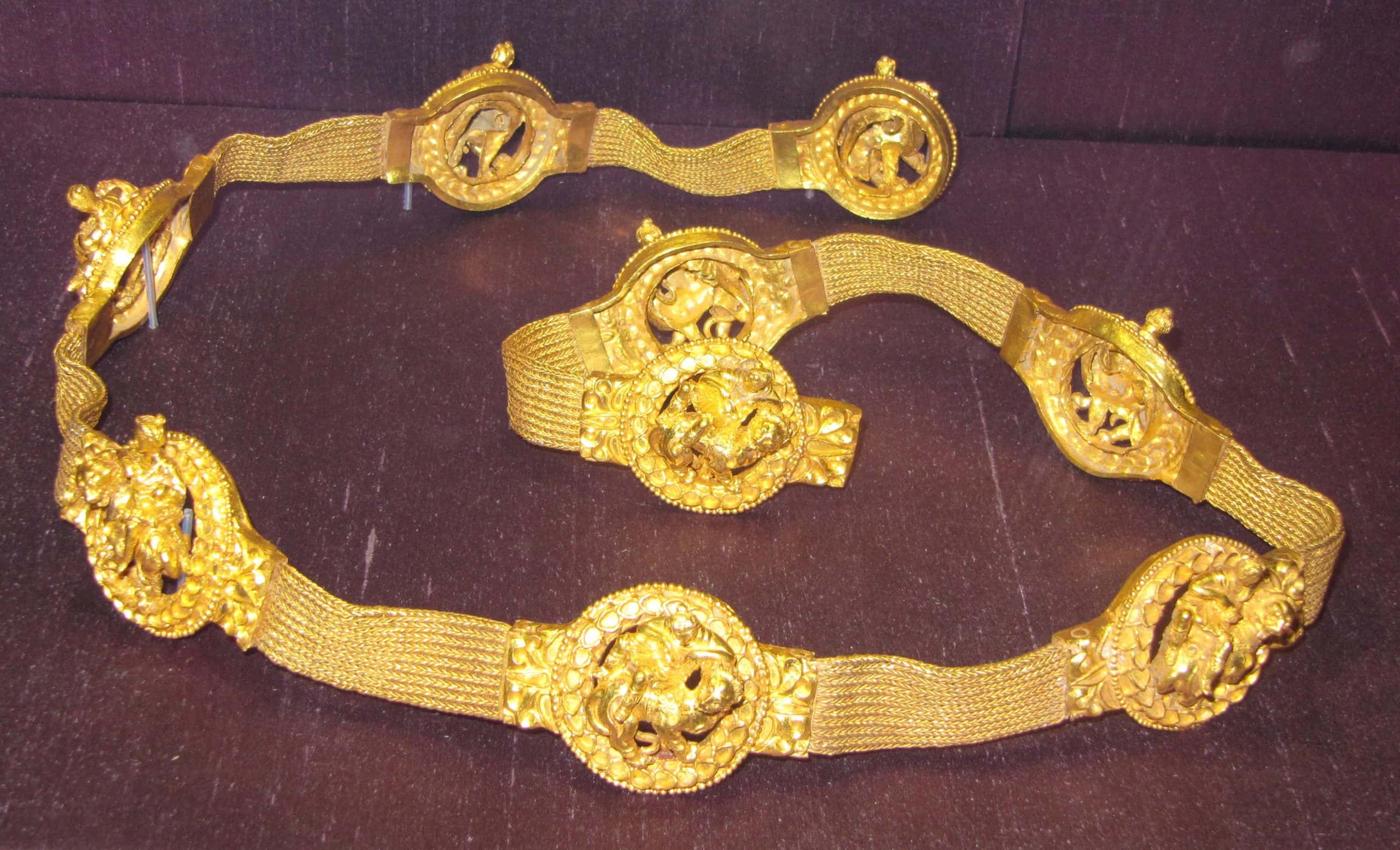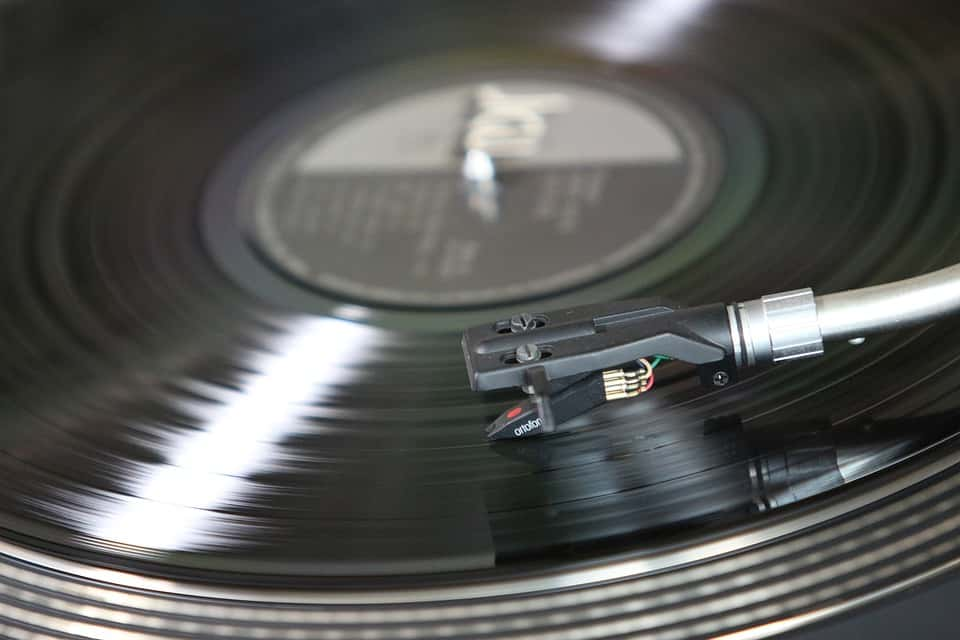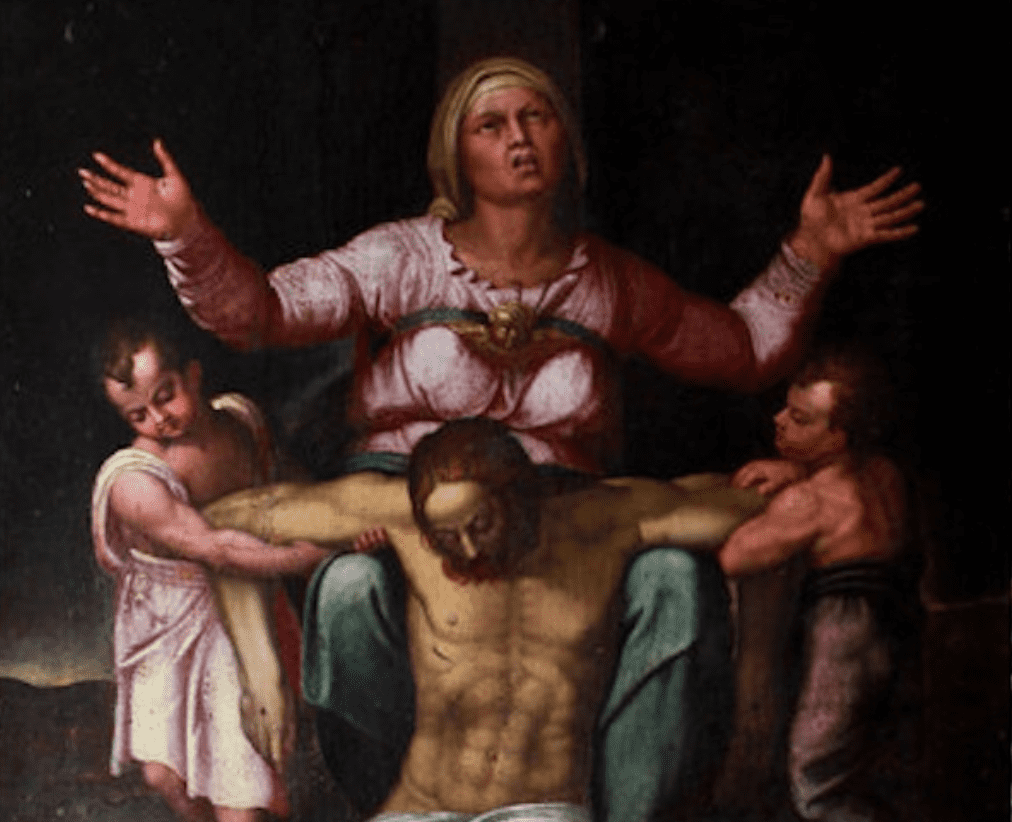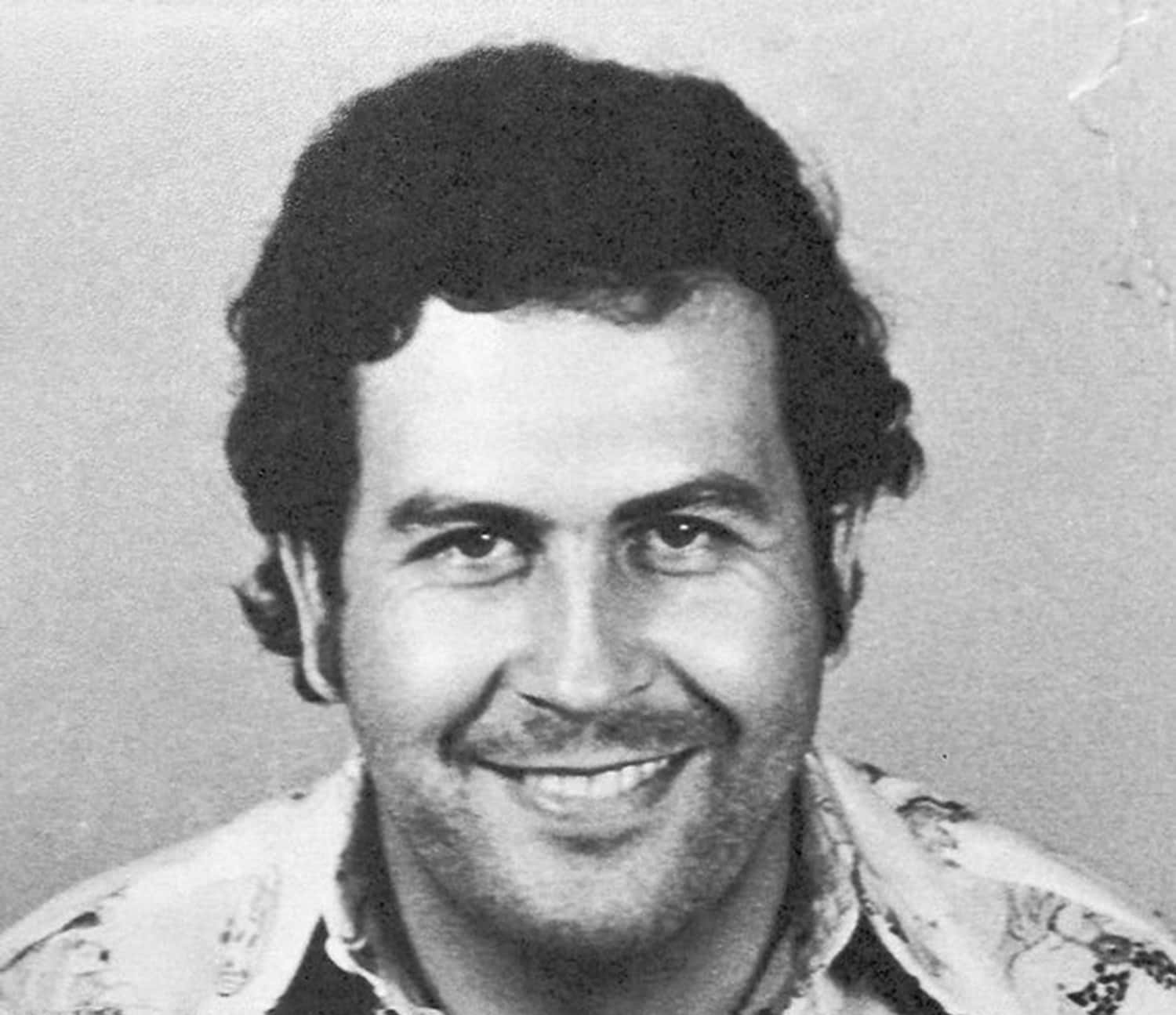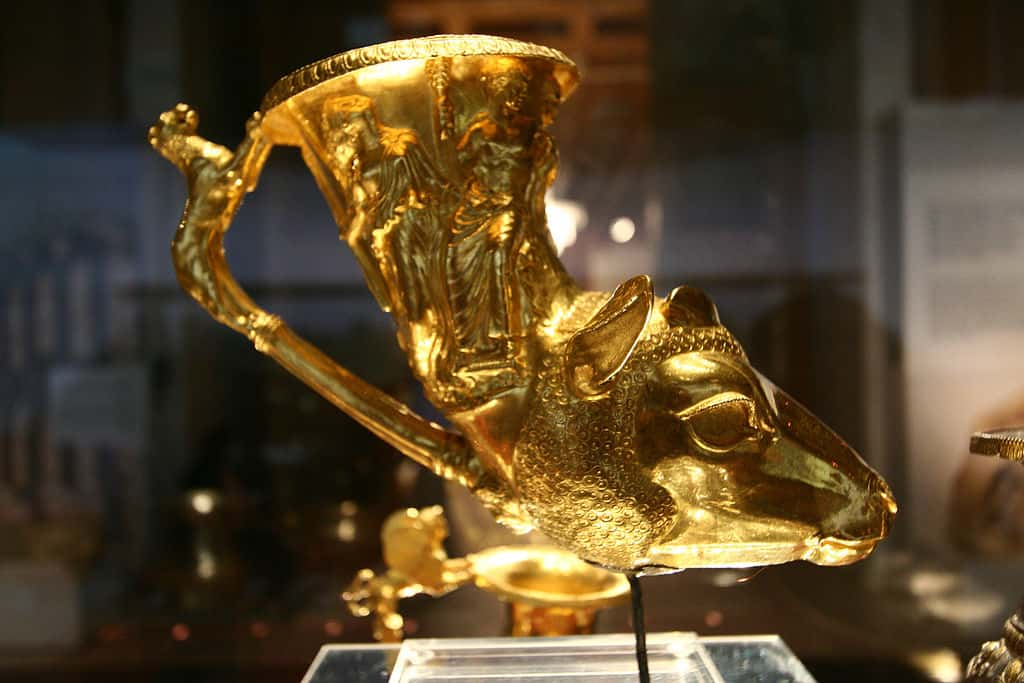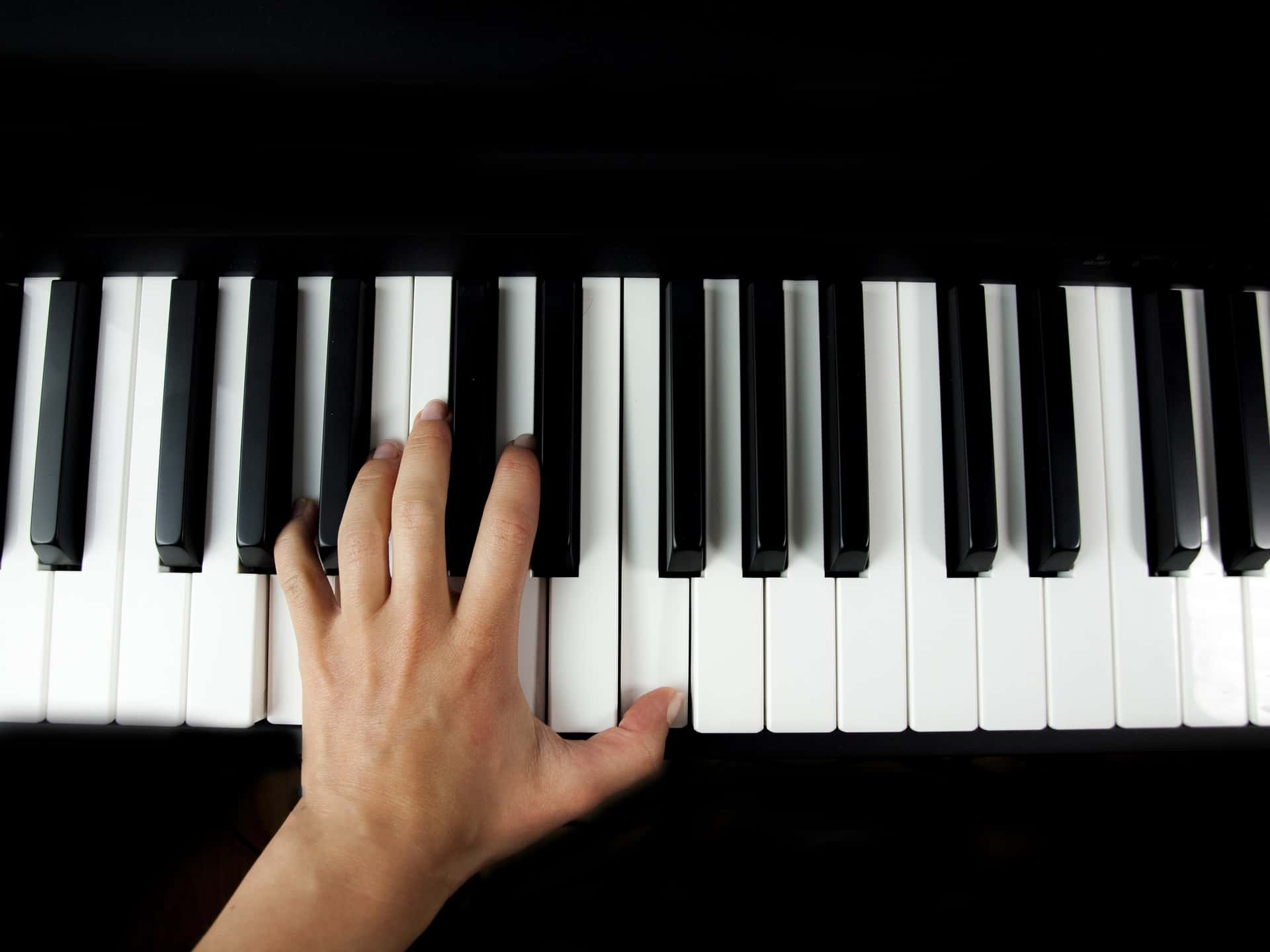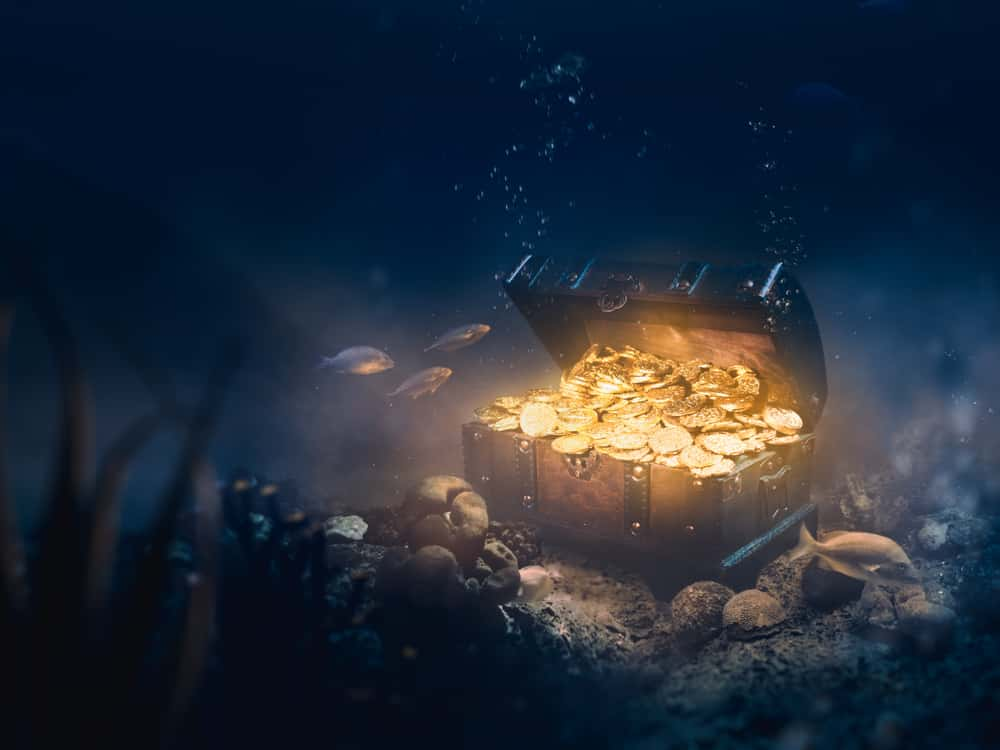Get out your metal detectors and sledge hammers and put your hard hats on—oh, and if you’re having any renovation done, you might want to agree with your contractors who gets to keep any treasure that may be found. Here are 43 facts about the largest, most important and most surprising hidden treasures ever discovered!
Hidden Treasures Facts
43. Bactrian Gold
In 1978, a year before the Soviet invasion of Afghanistan, archaeologists stumbled upon a literal treasure trove of gold, silver and ivory jewellery in six burial mounds in northern Afghanistan. The gold was buried on what’s now known as Tillya tepe, literally “Golden Hill,” somewhere between 100 BC and 100 AD. The hoard consists of 20,060 golden ornaments and coins. The gold went missing again during the Afghanistan civil wars but has since been recovered and is displayed in museums worldwide.
42. Iron Age Grave
An Iron Age tomb brimming with treasures made of gold, bronze and amber was found at Heuneburg, Germany in 2017, buried by a Celtic people in 583 BC. Thought to be the grave of a priestess, the tomb also included a petrified sea urchin. Besides the precious metal artifacts, excavators also found textiles, furs, carved boxwood objects and ornaments made of boar’s horns.
41. Roman Piggy Bank
A modest pot bellied clay jar was dug up by metal detector enthusiast David Crisp in Frome, England. Frome must have been surprised when he opened the jar to reveal 52,503 Roman coins, the largest cache ever found in England. Valued at £320,250, many of the coins are too corroded or dirty to identify, but certain silver coins, minted by Emperor Carausius, are of a finer condition than the ones in the British Museum.
40. An Eggy Investment
A Midwestern man thought he lost big when he spent $14,000 on a gold and jewelled decorative egg that turned out to only be worth $500 in materials. However, his luck changed when the egg was revealed to be a Fabergé Imperial Egg, lost since the 1800s. The egg was commissioned by Tsar Alexander III for his wife, Maria Feodorovna in 1887. It is one of only 43 surviving Fabergé eggs and it's worth an estimated $33 million. Not a bad return on investment.
39. Stamp-ede
They may be less impressive than a cache of gold coins, but they’re certainly easier to carry: 35 rare Chinese stamps worth £250,000 were found in an attic in an English village. The stamps, minted in 1882, were bought by a British missionary who returned home and stashed them in an attic, where they collected dust for over 100 years before being unearthed from the cigar box in which they were hidden.
38. Dog Walk Gold Rush
It was a relatively normal day for a California couple who were out walking their dog one morning… until they stumbled upon eight decaying metal cans full of gold coins! The 1,400 gold pieces, buried sometime during the Gold Rush days, are worth a reported $10 million. The coins were minted between 1847 and 1894 and represent the largest hidden treasure ever found on US soil.
37. Toddler Treasure
The world’s youngest ever treasure hunter? James Hyatt was only 3 years old when he picked up a metal detector for the first time… and uncovered a 16th century reliquary worth £2.5 million! The gold locket used to hold religious relics was found buried just 8 inches below the surface.
36. Coffin Liquor
During some routine maintenance at Britain’s Garden Museum, some workmen accidentally knocked a hole in the chancel floor. What lay beneath blew everyone away—a secret tomb containing 30 coffins, some belonging to former Archbishops of Canterbury, buried in the 1600s! This discovery is one of cultural significance rather than monetary value—though on display through a glass window, the coffins remain undisturbed for fear that liquified remains, known as “coffin liquor,” will spray forth if they're opened.
35. But I'd Still Like My Hammer Back...
It’s no wonder metal detectors are so popular in Britain—so many valuable treasures have been unearthed with their help! Yet Peter Whatling and Eric Lawes of Hoxne, England weren’t even looking for treasure when they uncovered a hoard of 14,865 gold, bronze, and silver coins dating from Roman times—the late 4th or early 5th centuries—plus 200 pieces of silver tableware and gold jewellery. The cache would be worth £3.21 million today. What were they looking for? A missing hammer. No word on whether or not they ever found it/cared.

History's most fascinating stories and darkest secrets, delivered to your inbox daily.
34. Spanish Gold
All in a day’s work: Construction workers renovating water pipes in Seville, Spain happened upon a cache of Roman coins weighing over 600 lbs and worth several million euros. The 3rd and 4th century bronze coins, stamped with inscriptions from Emperors Constantine and Maximian, were in such good condition they must never have entered circulation.
33. Finders Keepers?
In 2006 a small-time contractor from Cleveland unearthed boxes of well-preserved bills from 1937. The bills totalled a face value of $182,000, but as some of the bills are extremely rare and very well preserved, the estimated value of the currency is more than $500,000. The legal battle between the contractor who found the bills and the homeowner in whose walls the money was found still rages on, which has destroyed their former friendship and cost taxpayers thousands of dollars as a judge or jury will need to decide the fate of the find. Worth it? Ya, probably.
32. Super Bowl
An unassuming white ceramic bowl sat on a mantle after being bought at a garage sale for $3. Little did the buyers know that the only similar specimen has been in the collection of the British Museum for 60 years! The bowl was authenticated as an artifact from China’s Song Dynasty, created over 1000 years ago and now worth $2.2 million. That is not too shabby!
31. BillionMillion Dollar Babies
Rock star Alice Cooper unearthed a painting by Pop Art icon Andy Warhol in his own storage locker. Bought 40 years ago for $2,500, a similar print recently sold for $11.6 million. Cooper found the print, depicting the electric chair where Julius and Ethel Rosenberg were executed for treason, rolled up in a tube, coincidentally near a stage prop in the form of a fake electric chair.
30. Best Chest
In 1658, Cardinal Jules Mazarin (then the richest man in Europe) acquired two lacquered Japanese chests, which he brought home to France via Amsterdam. Through a series of auctions and estate sales, the chests were split up, with the smaller of the two ending up in the collection of the Victoria & Albert Museum. The other chest however, was lost to time until 2013 when a Polish family had the estate of their deceased father appraised, revealing the missing treasure. The chest had been acquired for £100 by a man who used it as a TV stand, then as a bar stand—presuming it was a modern reproduction. In a twist of fate, the forgotten chest actually ended up only a three minute walk from the V&A Museum containing it's mate. The chest sold for almost $10 million at auction in 2014.
29. Gone With the Plague
The largest treasure ever found in Poland was uncovered in 1985 during some routine maintenance work. Initially the treasure consisted of silver and gold coins, but subsequent excavations discovered more coins and even a jewelled crown. The treasure could be worth up to $100 million, but is so unique that it’s hard to determine the exact value. The treasure was thought to have belonged to King Charles IV of Luxembourg, who pawned it to a Jewish banker in Poland; it disappeared in the 1340s when the Black Plague swept across Poland and was missing until its rediscovery over 600 years later.
28. But I Found It!
A farmer in Ueken, Switzerland unearthed more than 4,000 bronze and silver coins of Roman origin that were buried in 294 AD in leather pouches. The coins were in excellent condition and they probably represented savings worth one or two years of salary when they were buried. According to Swiss law, found treasures belong to the public, so the farmer who found them would likely receive only a small finder's fee.
27. I Do Declare
A savvy flea market treasure hunter got more than he bargained for when he purchased a painting for $4. The painting itself was ugly to his tastes, but when he dismantled the frame a folded sheet of paper slipped out. That paper turned out to be an original copy of the Declaration of Independence, one of 24 surviving copies made in 1776, worth over $1 million!
26. Bones-Shmones
Bones attributed to St. Peter, the first Pope, laid at rest in a Roman church for 1000 years, presumably right where they should be. It’s just that nobody knew they were there! Construction workers discovered clay pots bearing inscriptions with the names of St. Peter, along with early popes Cornelius, Callixtus, and Felix, under a marble slab at the altar of the church. St. Peter is said to have been crucified upside-down out of respect for Christ during the first century AD, and his bones must have been moved to the church early after its consecration in the year 1090.
25. Sippy Cup
It looks like a crushed-up solo cup except, of course, one made from solid gold. The Ringlemere cup was discovered in 2001 by Cliff Bradshaw, a British metal detectorist, and it is one of only two examples of similar cups found in England. It was hammered from a single piece of gold and held with a handle, as the bottom is rounded. Dating from 1700-1500 BC, the cup, along with a few other treasures found nearby, was bought by the British Museum for £270,000, split between Bradshaw and the family who owned the land it was found on.
24. Like, Really Underground
Record collector Warren Hill just wanted to give a record marked with "The Velvet Underground 5-25-66" a listen when he purchased it for 75 cents at a Manhattan flea market. What he heard were versions of songs from the Velvet Underground’s first record which he had never heard before. The acetate album was a test-printing recorded before the band's final studio album and exists as one of only two copies in the world. Hill sold the record on eBay in 2006 for $155,406.
23. Worth Every Penny
Cousins Kevin and Martin Elliot’s family had been farming a barley field as tenants for 36 years until the two cousins bought it in January 1998, allowing them to use a metal detector on the land. Within minutes the device was beeping, revealing a cache of 9,213 Roman silver dinari coins worth a whopping £265,000!
22. Like Mike
An unfinished painting nicknamed “The Mike” was knocked of the Kober family’s wall by a tennis ball and stashed behind a sofa for 27 years before Mr. Kober decided to have it authenticated in 2003. The nickname was apt—not only did it resemble a Michelangelo, it was a Michaelangelo. The painting depicts a famous sculpture by Michaelangelo which resides in St. Peter’s Basilica in Rome and scholars have been searching for the painting for years. It's worth upwards of $300 million.
21. The Couch Holds Many Secrets
A Berlin student found a painting worth $27,630 hidden within a pull-out couch that they bought for $215. The tiny painting, only ten inches by fifteen inches, dates from between 1605 and 1620 and was titled "Preparation to Escape to Egypt."
20. Keep it Safe
Columbian drug lord Pablo Escobar was famous for having stashes of wealth hidden in safes around his properties, so much so that Christian de Berdouare bought one of Escobar’s former mansions for the sole purpose of demolishing it to look for treasure (and to build a bigger mansion on the site). Berdouare actually succeeded in his goal and found a safe on his recently purchased property. It’s unclear what was in this specific safe, but Escobar was known to hide cash, diamonds, and guns all over his properties during the height of his drug-smuggling career when he was making $400 million per month! Hiding that kind of illegal dough isn’t easy—his brother once speculated that 10% of his income was lost to water damage and rodents.
19. Deadly Treasure Hunt
Okay, not technically a treasure found, but the discovered remains of treasure hunter Eric Ashby represent a $2 million treasure still out there to be located. Ashby went missing after his raft capsized earlier this year while he was on the trail of a treasure rumored to be buried by art collector Forrest Fenn in the Rocky Mountains. Fenn claims to have hidden a bronze chest filled with 265 gold coins, gems, rubies and gold nuggets in 2010 and has left clues in two of his books to find the treasure. While Fenn claims to be encouraging families to get outdoors and spend time together searching for the treasure, Ashby is the third man to have died while searching for it.
18. Those Sneaky Anglo-Saxons
In 2009 Terry Herbert stumbled upon the largest stash of Anglo-Saxon artifacts ever found, worth $4.1 million. 3500 items dating to the 8th century were discovered including weaponry, religious artifacts and decorative objects which have shed light onto Anglo-Saxon culture and manufacturing techniques, making the cache even more valuable from an anthropological perspective. Among the discoveries: a sneaky way of goldsmithing devised to make 12 karat gold resemble 23 karat gold!
17. History in Coins
Some treasures are discovered exactly where you think they should be and the Ophel treasure fits into this category. Discovered at the foot of the Temple Mount in Jerusalem by a team from Hebrew University, it consists of a rather small collection of only 36 gold coins. The 1400-year-old coins bear engraved Jewish symbols such as a menorah, a shofar and a Torah, representing an important piece of Jewish history in the area.
16. Secret Nazi Stash
It’s like something out of Indiana Jones—police in Buenos Aires discovered a secret passage concealed behind a bookcase in 2017, revealing a hidden room holding 75 original Nazi objects. Medals, statues and a miniature bust of Hitler are thought to have been smuggled in by infamous Nazi physicist Josef Mengele, aka the “Angel of Death,” responsible for human experimentation on Jewish prisoners in World War II. Some artifacts were accompanied by photos of Hitler using the objects in question, a way to increase market value. An antiquities dealer already under scrutiny for trading in illegal Chinese and Egyptian artifacts is being investigated in connection with the cache. The Nazi memorabilia will not be ending up in private hands.
15. Roadshow Paydirt
The Angel of the North is a steel sculpture standing 20 metres tall and bearing wings 177 feet in length. The Angel, designed by Antony Gormley and built in 1998, resides at Tyne and Wear, England, a fine work of public art. Apparently the statue was a hard sell, and Gormley had to build a prototype to convince officials in Gateshead to pay for it—a prototype which was forgotten in their offices for 15 years. When the statue was discovered and brought on Antiques Roadshow, it was valued at £1 million, the highest valuation ever for the program at that time!
14. Cat Scratch Treasure
A 7-inch-tall sculpture of a cat’s head with a golden earring, deemed too ugly to sell at an estate sale in England, was revealed to be an Ancient Egyptian artifact worth up to £50,000! The cat bust is believed to originate from 600 BC and may have belonged to Howard Carter—the man who discovered Tutankhamun’s tomb.
13. Nazi Gold
The SS Minden, a Nazi ship used to transport gold from banks in South America, sank in 1939 off the coast of Iceland, but this year British treasure hunters may have located the spoils. Advanced Marine Services discovered the shipwreck, which was scuttled by her own crew to avoid capture, but are currently embroiled in a legal battle with the Icelandic government over who owns found treasure, so the contents of the wreck, possibly up to 4 tons of Nazi gold, remain a mystery.
12. If This Bed's a Rockin'...
A bed belonging to King Henry VII and Elizabeth of York—possibly the very bed in which King Henry VIII was conceived—was discovered in a decidedly un-royal place in England in 2013. The intricately carved oak bed was thrown out in a parking lot and placed up for auction, where it fetched £2,200. It was snapped up by a furniture expert who had the wherewithal to have the bed investigated, where it was discovered to be the only surviving example of a Tudor bed and was revealed by DNA analysis to have belonged to the King. With its royal provenance, this bed could literally be the birthplace of the Tudor monarchy.
11. Siebenberg Israel treasure,1970
Theo and Miriam Siebenberg didn’t have to venture far from their Jerusalem home to discover a 2000-year-old archaeological treasure. In fact, they only had to look under their home. Siebenberg was initially told that if he dug beneath his home his whole neighbourhood could collapse. He self-funded a costly and intricate excavation that turned up artifacts such as rings and arrowheads but also architecture: a 2000 year old wall, two Jewish ritual baths, a Byzantine cistern and burial chambers dated to 2600 years old.
10. Whistle Blower
Three brothers were digging for clay near a factory in Bulgaria when they found what they thought was a whistle. The whistle (which turned out to be a ceremonial drinking horn) happened to be made of solid gold, and further excavation uncovered thirteen pounds of intricately carved and decorated golden ornaments that dated to the 4th century BC.
9. A Coin For Your Efforts
Workmen on the River Ribble near Preston in England uncovered a simple lead box which contained one of the biggest hoards of Viking treasure ever uncovered. 8600 items, including coins, jewellery, and silver ingots were traced to Scandinavia, Italy, and Byzantium. The treasure, valued at $3.2 million today, was presented to Queen Victoria, while the workmen who found got to keep one coin each. That sounds like a raw deal to me!
8. Vale of York Viking Hoard, 2007
Second in size only to the Cuerdale Hoard, The Vale of York Viking hoard was a 10th century cache of 617 coins and 65 other artifacts. Treasure hunter David Whelan and his son, with the aid of metal detectors, discovered a lead box out of which a silver cup fell. The pair had the wherewithal to keep the box intact so that it could be unpacked by experts. Those experts valued the find at just over £1 million, which was paid by several museums who split the treasure amongst themselves for public display.
7. As If One Lost City Wasn't Enough
In his 2017 book, The Lost City Of The Monkey God, journalist Douglas Preston tells the story of an incredible archaeological discovery with technology that puts metal detectors to shame. LiDAR, or Light Detection And Ranging, uses a high-resolution laser detection to map out sections of jungle that could conceal ruins from the human eye. Between 2012 and 2015, Preston accompanied a team of LiDAR scientists to the remote Mosquitia region of Honduras, where they uncovered not one but two lost cities!
6. Grand, Grand Piano
A treasure trove of over 900 gold sovereigns was found inside a piano donated to Bishop’s Castle Community College in Shropshire, England by a piano tuner attempting to tune the 110-year-old instrument. The cache contained 633 full sovereigns and 280 half sovereigns made of gold and silver dating between 1847 and 1915. The piano was donated by a couple who were “downsizing” their home and had no idea their piano contained such a treasure. The riches will be split between the school and Martin Backhouse, the piano tuner who discovered the coins. The couple was out of luck.
5. Priceless Shipwreck
Divers first thought they’d found a child’s toy when they spotted a gold coin in the harbor of Caesarea National Park, Israel. The coin ended up being from a 1,600-year-old shipwreck that also held bronze lamps, statues of the Moon goddess Luna plus 40 pounds of Roman coins. The best estimate for the value of the trove? Priceless.
4. Rain, Rain, Go Away... I Mean Thank You!
After a heavy rainstorm opened up a three-foot-wide sinkhole at the base of the Temple of the Feathered Serpent in Tiotihuacan, Mexico, archeologists Sergio Gómez Chávez and Julie Gazzola couldn’t wait to investigate. Gomez was lowered on a rope by colleagues into what he realized was no sink hole at all but a perfectly cylindrical shaft, discovering a tunnel sealed since 200 BC. When a larger-scale archaeological investigation was conducted, it was revealed that the sinkhole entrance was a false entrance, and the real tunnel opening was found. The tunnel contained miniature landscapes created with pools of mercury resembling lakes and pyrite and hematite powder on the ceiling resembling stars. Greenstone statues, wooden masks, pendants and pyrite mirrors were also found.
3. Hey, We'll Take It
In 2017 archaeologists discovered a twelfth cave associated with the Dead Sea Scroll, and even though it had long since been mostly cleared out by looters, they're still extremely excited about the discovery. The first cave uncovered since 1956, all that remained were storage jars and fragments of leather used to tie scrolls together. Why is this so exciting? Because it confirms the existence of missing scrolls in the first place, and tiny scroll fragments left behind can be used to authenticate any scrolls that do turn up. The Dead Sea Scrolls are considered the most important archaeological find of the century; new scrolls that are discovered would be a great addition to the world’s knowledge… or to the private collection of an unscrupulous antiquarian.
2. One Trillion Dollars
The Sree Padmanabhaswamy Temple in India is already impressively opulent: It’s known as the “Golden Temple” because it's covered in fine gold leaf. However, recent discoveries have put what was already the most wealthy temple in the world even more into the red: secret vaults discovered deep inside the temple were opened and found to contain untold riches: an 18 foot pure gold chain, a 36 pound gold veil, gold statues, coconut shells studded with diamonds, rubies, and other gems, a pure gold throne studded with diamonds and large enough to accommodate an 18 foot long Deity… the list goes on, to a value of $19 billion, not even taking into account cultural value (which could triple that estimate). Of six vaults, one remains: the largest and most mysterious, said to contain the bulk of the riches. Compared to the other vaults already open, it’s surmised there could be an additional $1 trillion worth of gold still within the temple vaults.
1. My Lips Are Sealed
Treasure hunter Tommy G. Thompson, called “perhaps one of the smartest fugitives ever,” is currently sitting in a jail cell because he discovered a long hidden shipwreck filled with gold, but wouldn’t share the profits with the investors who funded his expedition. His discovery was one of the richest finds in US history, over three tons of sunken gold. In 1857 the S.S. Central America sunk of the coast of South Carolina, taking its crew of 425 and its precious cargo with it. Thompson poured over route maps and developed new technology to find the gold, but he also used more than $12 million from several investors who never saw an ounce of the gold. Thompson has been jailed until he reveals the whereabouts of the gold, and if he keeps his mouth shut, the treasure will once again be lost to history.
Sources: 1, 2, 3, 4, 5, 6, 7, 8, 9, 10, 11, 12, 13, 14, 15, 16, 17, 18, 19, 20, 21, 22, 23, 24, 25, 26, 27, 28, 29, 30, 31, 32, 33, 34, 35, 36, 37, 38, 39, 40, 41, 42, 43, 44, 45


